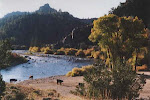
by Abrahm Lustgarten, ProPublica - October 22, 2009 11:00 pm EST
New York's recently released review of the environmental risks [1] (PDF) posed by natural gas production in the Marcellus Shale offers the clearest picture yet of the chemicals used in the drilling process called hydraulic fracturing.
The document makes public the names of 260 chemicals, more than eight times as many as Pennsylvania state regulators have compiled. The list is the most complete released by any state or federal agency and could help answer concerns about hydraulic fracturing in Congress and in states where gas drilling has increased in recent years.
The review also takes another dramatic step by proposing that in certain situations companies that drill in New York be required to report the concentrations of the chemicals they use to state regulators, thereby creating a suite of information that environmental scientists say is essential to investigating water pollution from drilling. New York would be the first state to make such a demand.
The industry has been reluctant to release information about the chemicals it uses, because it considers them a proprietary trade secret. While New York has made the names of the chemicals public, it seems likely that the data about their concentration will be shared only with state officials.
The 800-page environmental impact assessment also proposes a slew of safeguards for well construction, waste disposal and water protection. If those rules are finalized after the ongoing public review period, New York's environmental protections for gas drilling would be among the strongest in the nation.
"In a number of areas these regulations are more stringent than in other states," said Kate Sinding, a senior attorney with the Natural Resources Defense Council. "As commendable as that is, and wanting to give the department credit where credit is due, the bar set in most other states is so abysmally low, it still begs the question of whether stronger is strong enough."
Environmental scientists have long sought complete information about the chemicals used in hydraulic fracturing, saying they need it to thoroughly investigate water pollution. Contamination can occur when the chemicals are pumped underground, held in waste pits or trucked to water treatment plants before being discharged back into rivers and drinking water supplies.
Colorado passed regulations last year requiring companies to disclose the names of chemicals, but they apply only to chemicals held in 50-gallons drums or larger. Now the industry is suing Colorado to repeal the group of regulations that includes that clause. In Pennsylvania, environment officials told ProPublica that their list of chemical products used for drilling there was complete, but it names just 39 products and 31 unique chemicals. Congress has been debating a bill to require disclosure, but the industry is fighting the legislation with millions of dollars in lobbying efforts.
New York obtained the names of the chemicals by surveying drilling companies, their contractors and the manufacturers of the chemicals. The Department of Environmental Conservation identified 152 trademarked products and obtained the complete list of their ingredients; it gathered a partial list of ingredients for an additional 45 products.
The review, which was released last month, leaves some environmental concerns unanswered. It offers few specific measures to protect New York City's watershed -- the unfiltered source of drinking water for nearly half the state's population. It says that wastewater will be treated by facilities in New York and Pennsylvania, but does not confirm whether those plants have the capacity to receive Marcellus Shale wastewater or the technology to make that water safe. Critics also complain it does little to describe how several thousand new wells would cumulatively affect air and water quality, leaving the analysis to a per-well basis..........more...........










